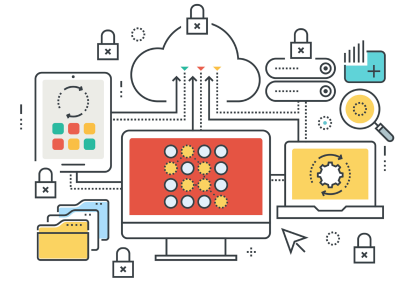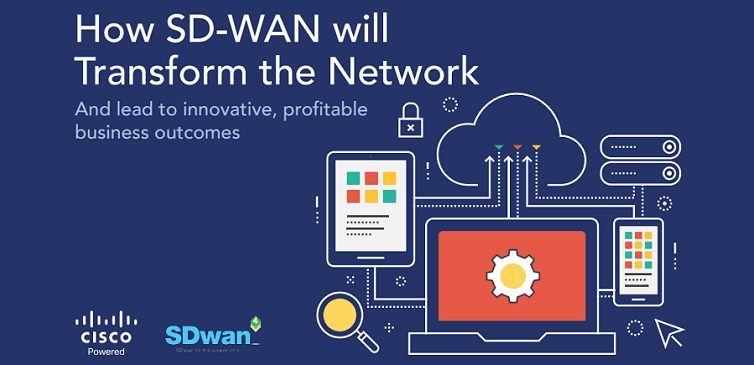By 2020, more than 50% of WAN edge infrastructure refresh initiatives will be based on SD-WAN versus traditional routers.
The reason for moving to Software-Defined Wide Area Networks (SD-WAN) is that businesses in nearly every sector are seeking gains in productivity, efficiency and cost reduction won from cloud-based applications and the Internet of Things (IoT).
SDwan4 is a new generation service that enables optimal connectivity to OurDC4 cloud environment. OurDC4 is built in secure, Australian data centres and integrates four partners including Cisco, Pure Storage, Rubrik and Secure Agility, into one unique capability.
Existing wide area networks, based on Multiprotocol Label Switching (MPLS), are unable to deliver the necessary increase in bandwidth, cloud connectivity optimisation, and enhanced security to achieve the benefits of cloud-based apps and IoT technology. That’s why companies are turning to Cisco for enterprise-grade SD-WAN technology, with intent-based networking, to solve their challenges through a carrier- and transport-agnostic cloud-delivered overlay WAN architecture.
SD-wan4 Cloud Managed SD-WAN networks, powered by Cisco come with substantially lower WAN costs, reduced deployment times, application resiliency and the robust security that MPLS can’t deliver.
Benefits you can achieve by using SD-WAN

Examples of how organisations have achieved success include:
- 80% reduction in cost/Mbps for a national insurance provider
- $20M reduction in Operating Expenses (OpEx) over three years for a retailer
- 5-fold improvement in Office 365 performance for an energy provider
- 100% application uptime during network failures for a national food distributor
- 4-fold improvement in application latency for a healthcare provider
- 12-fold improvement in change control time for a 3,000-site bank
- M&A integration within 2 weeks for a Fortune 50 healthcare provider
- Guest wireless deployment at more than 1,000 stores for a retailer
- Securely isolated more than 100 business partners for a manufacturer with more than 1,000 sites in the US
Outcomes such as these illustrate why organisations are using SD-WAN. This shift—along with the surge in IoT, mobile devices, and media-rich applications—is enabled by the increase in bandwidth and the predictable and fast performance that SD-WAN can deliver.
SD-WAN delivers on all fronts
Organisations need to provide users with dynamic access while achieving agility in responding to changing demands. SD-WAN powered by Cisco delivers on those ends as well as:
- Provides optimised cloud access and a better user experience. Many networking cloud solutions offer a hodgepodge of options, a lack of consistency and a poor user experience. SD-WAN—with its optimised performance for major SaaS applications—provides agile solutions to onboard public cloud access on Google Cloud and Microsoft Azure®, ensuring great user experiences.
- Delivers reliable application performance and availability. Without dependable performance, business-critical applications can crash. SD-WAN meets tough service level agreements (SLAs), even during link outages and other network events.
- Offers greater agility. Existing WANs lead to infrastructure sprawl with their complex amalgamation of devices and appliances. SD-WAN enables faster, easier WAN deployment and operation, as well as faster performance while using less bandwidth, and helps you deploy new revenue generating services in minutes—not months.
- Provides advanced threat protection. Given the increased sophistication of cyber threats, traditional WANs can leave businesses unprotected. SD-WAN employs the zero-trust model. Every component mutually authenticates each other, all edge devices are authorised before they are allowed into the network, and every packet is encrypted using SSL and IP Security (IPsec) technologies.
- Ensures a resilient network. Traditional WANs can be prone to faults, even during normal operations. SD-WAN is designed for fail over and to choose the best or optimised path at all times.
- Separates the control plane and data plane. SD-WAN provides a clear separation between management-plane, control plane and data plane. This enables each component to work independently and efficiently, as well as facilitates scaling of components based on the network needs.
- Enables zero touch provisioning. SD-WAN routers are configured and managed using zero touch provisioning (ZTP), cutting device and maintenance operational expenses.
- Reduces WAN expenses while increasing bandwidth. One of the most expensive IT budget line items is the WAN. This can result in insufficient bandwidth at branches and other locations, leading to poor user experiences. SD-WAN powered by Cisco can provide increased bandwidth at a reduced cost.
SD-WAN with intent-based networking constantly learns, adapts and protects the network
The advantages of intent-based networking include:
- Simplifying policy management across all your remote sites through machine learning and advanced orchestration with centralised cloud managed fabric to improve scale, performance and monitoring of your WAN, while reducing the complexity of managing network policies
- Securely connecting users to applications over any type of connection including MPLS, Internet and 4G LTE
- Automating the provisioning of new branch locations and network services in minutes rather than months
- Offering end-point flexibility to support any type of end-point (physical or virtual) to deliver rich services including WAN Op, firewall or basic WAN connectivity as well as branch, WAN aggregation and cloud
- Enforcing multi-layer security for hybrid cloud-based and on-premise infrastructure including encryption, authentication, segmentation and service chaining
- Enhancing application quality of experience through real-time application optimisation for productivity and SaaS applications, and intent-based dynamic path control for network and application performance optimisation
- Using data analytics to optimise the application experience
SD-WAN delivers an end-to-end secure platform across the access, WAN, data center and cloud for the digital business
SD-WAN simplifies how organisations move workloads to any cloud, consume cloud hosted applications or enable new services in remote locations. By providing the strongest security and the flexibility to support any platform, SD-WAN ensures that your users always have the best possible experience with the highest protection over any type of WAN connection. Using advanced analytics, SD-WAN makes your WAN smarter by continuously optimising application performance and providing protection from sophisticated threats.

Download the eBook: How SD-WAN will Transform the Network
Today, IT departments are under pressure to do more with less: manage more sites and more clients with limited budgets and a relatively small team, all without any reduction in reliability and security. With an SD-WAN, you can lower costs while managing your entire network from a centralised dashboard, rapidly deploying new branches with any transport, and automating operational workflows.
Download our eBook to learn more how companies can benefit with SD-WAN. Fill out the form below to download your free copy:




